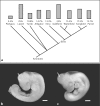Phylogenetic origins of early alterations in brain region proportions
- PMID: 20332607
- PMCID: PMC2914409
- DOI: 10.1159/000300573
Phylogenetic origins of early alterations in brain region proportions
Abstract
Adult galliform birds (e.g. chickens) exhibit a relatively small telencephalon and a proportionately large optic tectum compared with parrots and songbirds. We previously examined the embryonic origins of these adult species differences and found that the optic tectum is larger in quail than in parakeets and songbirds at early stages of development, prior to tectal neurogenesis onset. The aim of this study was to determine whether a proportionately large presumptive tectum is a primitive condition within birds or a derived feature of quail and other galliform birds. To this end, we examined embryonic brains of several avian species (emus, parrots, songbirds, waterfowl, galliform birds), reptiles (3 lizard species, alligators, turtles) and a monotreme (platypuses). Brain region volumes were estimated from serial Nissl-stained sections. We found that the embryos of galliform birds and lizards exhibit a proportionally larger presumptive tectum than all the other examined species. The presumptive tectum of the platypus is unusually small. The most parsimonious interpretation of these data is that the expanded embryonic tectum of lizards and galliform birds is a derived feature in both of these taxonomic groups.
Copyright 2010 S. Karger AG, Basel.
Figures


Similar articles
-
Developmental origins of species differences in telencephalon and tectum size: morphometric comparisons between a parakeet (Melopsittacus undulatus) and a quail (Colinus virgianus).J Comp Neurol. 2008 Apr 10;507(5):1663-75. doi: 10.1002/cne.21640. J Comp Neurol. 2008. PMID: 18241052
-
Allometric scaling of the tectofugal pathway in birds.Brain Behav Evol. 2010;75(2):122-37. doi: 10.1159/000311729. Epub 2010 May 28. Brain Behav Evol. 2010. PMID: 20516660
-
Basal ganglionic pathways to the tectum: studies in reptiles.J Comp Neurol. 1980 Sep 15;193(2):565-89. doi: 10.1002/cne.901930217. J Comp Neurol. 1980. PMID: 7440783
-
Early development and embryology of the platypus.Philos Trans R Soc Lond B Biol Sci. 1998 Jul 29;353(1372):1101-14. doi: 10.1098/rstb.1998.0269. Philos Trans R Soc Lond B Biol Sci. 1998. PMID: 9720108 Free PMC article. Review.
-
The optic tectum of birds: mapping our way to understanding visual processing.Can J Exp Psychol. 2009 Dec;63(4):328-38. doi: 10.1037/a0016826. Can J Exp Psychol. 2009. PMID: 20025392 Review.
Cited by
-
Memory-Based Navigation in Elephants: Implications for Survival Strategies and Conservation.Vet Sci. 2025 Mar 30;12(4):312. doi: 10.3390/vetsci12040312. Vet Sci. 2025. PMID: 40284814 Free PMC article. Review.
-
Bigger brains cycle faster before neurogenesis begins: a comparison of brain development between chickens and bobwhite quail.Proc Biol Sci. 2010 Nov 22;277(1699):3469-75. doi: 10.1098/rspb.2010.0811. Epub 2010 Jun 9. Proc Biol Sci. 2010. PMID: 20534617 Free PMC article.
-
Rescuing Perishable Neuroanatomical Information from a Threatened Biodiversity Hotspot: Remote Field Methods for Brain Tissue Preservation Validated by Cytoarchitectonic Analysis, Immunohistochemistry, and X-Ray Microcomputed Tomography.PLoS One. 2016 May 19;11(5):e0155824. doi: 10.1371/journal.pone.0155824. eCollection 2016. PLoS One. 2016. PMID: 27196138 Free PMC article.
-
Evo-devo and brain scaling: candidate developmental mechanisms for variation and constancy in vertebrate brain evolution.Brain Behav Evol. 2011;78(3):248-57. doi: 10.1159/000329851. Epub 2011 Aug 23. Brain Behav Evol. 2011. PMID: 21860220 Free PMC article. Review.
-
Modeling transformations of neurodevelopmental sequences across mammalian species.J Neurosci. 2013 Apr 24;33(17):7368-83. doi: 10.1523/JNEUROSCI.5746-12.2013. J Neurosci. 2013. PMID: 23616543 Free PMC article.
References
-
- Araki I, Nakamura H. Engrailed defines the position of dorsal di-mesencephalic boundary by repressing diencephalic fate. Development. 1999;126:5127–5135. - PubMed
-
- Barton RA, Harvey PH. Mosaic evolution of brain structure in mammals. Nature. 2000;405:1055–1058. - PubMed
-
- Boire D, Baron G. Allometric comparison of brain and main brain subdivisions in birds. J Brain Res. 1994;35:49–66. - PubMed
-
- Carter AM. Sources of comparative studies of Placentation. 1. Embryological collections. Placenta. 2008;29:95–98. - PubMed
-
- Charvet CJ, Striedter GF. Developmental origins of mosaic brain evolution: morphometric analysis of the developing zebra finch brain. J Comp Neurol. 2009a;514:203–213. - PubMed
Publication types
MeSH terms
LinkOut - more resources
Full Text Sources

